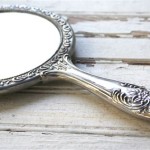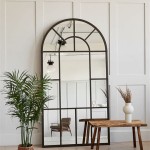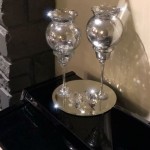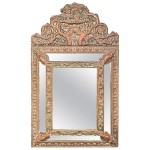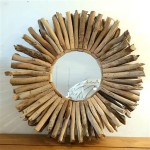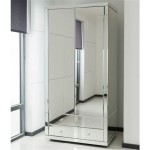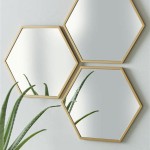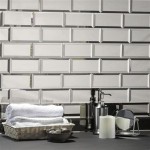How To Make A Mirror Waterproof
Mirrors, with their reflective surfaces, are susceptible to damage from moisture. Standard mirrors consist of a thin layer of reflective silver or aluminum applied to the back of a glass sheet, protected by a layer of paint. This protective layer is often insufficient to prevent water ingress, especially in high-humidity environments like bathrooms. Water can seep through the backing, oxidizing the reflective layer and causing unsightly black spots or cloudy areas. Therefore, implementing waterproofing measures is essential to prolonging a mirror's lifespan and maintaining its reflective qualities.
Sealing the Edges
One of the most vulnerable areas for water penetration is the edges of the mirror. The edges expose the reflective backing and offer a direct path for moisture to reach the metallic layer. Sealing these edges is a crucial first step in waterproofing. Various sealants can be employed, including silicone sealant, mirror mastic, or specialized mirror edge sealant. These products create a waterproof barrier, preventing water from entering along the periphery of the mirror.
Before applying sealant, the mirror edges must be thoroughly cleaned and dried. Any existing sealant or adhesive residue should be removed to ensure proper adhesion. The sealant should then be applied evenly and smoothly along the entire perimeter of the mirror's backside, where the glass meets the backing. Allow the sealant to cure completely according to the manufacturer's instructions before exposing the mirror to moisture. This process creates a robust barrier against water damage.
Protecting the Backing
While sealing the edges is crucial, protecting the entire backing of the mirror provides an additional layer of defense against moisture. Applying a waterproof membrane or coating over the back of the mirror creates a protective shield, further preventing water penetration. Suitable options include waterproof mirror backing paint or a clear waterproofing sealant. These products form a barrier against humidity and water splashes, safeguarding the reflective layer from oxidation.
When applying a waterproof coating, ensure the back of the mirror is clean and free of dust or debris. The coating should be applied evenly across the entire surface, ensuring complete coverage. Multiple coats may be necessary to achieve optimal protection, allowing each coat to dry thoroughly before applying the next. This meticulous application guarantees a continuous waterproof barrier, enhancing the mirror's resistance to moisture.
Environmental Considerations
Beyond applying sealants and coatings, environmental factors play a significant role in preventing mirror damage. Proper ventilation in bathrooms is crucial for minimizing humidity levels. Exhaust fans should be used during and after showers or baths to remove excess moisture from the air. This reduces the likelihood of condensation forming on the mirror's surface, which can eventually lead to water damage if left unchecked.
Furthermore, avoiding direct contact between the mirror surface and water is advisable. Splashes from sinks or showers should be wiped away promptly to prevent water from accumulating along the edges. In addition, regular cleaning with a mild glass cleaner and a soft cloth helps maintain the integrity of the mirror's surface and any applied sealants, preventing the buildup of grime and moisture that can contribute to deterioration.
Choosing the Right Mirror
While waterproofing methods can significantly enhance a mirror’s resistance to moisture, selecting a mirror specifically designed for bathroom environments can provide an added advantage. Some manufacturers offer mirrors with enhanced moisture protection, such as sealed edges and specialized backings. These mirrors are specifically engineered to withstand the high humidity levels typical of bathrooms, offering a more durable and long-lasting solution.
When selecting a bathroom mirror, consider opting for one with a copper-free backing. Copper-free mirrors are less prone to oxidation than traditional silver-backed mirrors, making them a more suitable choice for humid environments. While copper-free mirrors may be slightly more expensive, their enhanced resistance to moisture can ultimately save money on replacements in the long run.
Regular Maintenance
Even with proper waterproofing and environmental control, regular maintenance is essential for preserving the integrity of bathroom mirrors. Periodically inspect the edges and backing for any signs of sealant deterioration or damage. If any gaps or cracks are detected, reapply sealant promptly to prevent water infiltration. Regularly cleaning the mirror with a gentle glass cleaner also helps remove any residue or buildup that could compromise the waterproof barrier, ensuring the mirror’s longevity and pristine appearance.

How To Make Side Mirror Water Resistant Autoshala

How To Weatherproof A Garden Mirror Hometalk

Water Membrane For Car Rear View Mirror Waterproof Anti Fog Scratch

How To Weatherproof A Garden Mirror Houzewize

How To Weatherproof A Garden Mirror Houzewize

Waterproof How Do You Weatherproof A Garden Mirror Outside Organize With Sandy

Make Your Car Mirrors Rainproof And Fog Free With This Clear Temu Mexico

Make Car Mirrors Rainproof Clear Rain Temu

Gocomma Car Side Rear View Mirror Waterproof Review Carplay Life

Car Rear View Mirror Waterproofing Membrane 95 95mm

